This post is a deep dive into newsletters for life coaches and, except the glossary of terms, has been entirely hand-crafted without any interference from AI.
It’s easy to be overwhelmed by the amount of content, but there’s no need.
It’s written in sections, and you can use the table of contents to navigate to the most useful elements relevant to your immediate needs as a coach to get clients.
Similarly, you should bookmark the page so it’s a resource whenever you want to return.
The whole thing has taken me well over 20 hours to write and research and another couple of hours for my VA to do the images, so if you think it has value, a social media share would be so appreciated.
Note: You may notice comments going back to 2018 under the post. I had an established post I didn’t want to use the authority the URL had with Google. But the post is 90% different from the original post. If you want to know more about this technical type of workaround, sign up for The Pro List (it’s free)

Newsletters for Life Coaches – Why you need a newsletter list
Your newsletter list will be paramount to becoming a fully booked coach.
Over 75% of the people who book consults with me are already on my email list.
Also, my conversion rate from those consults is double that of people who have just found me doing a Google search.
The Fully Booked Coach Facebook Group is important and brings me clients.
Similarly, my blog is important to my SEO (search engine optimisation) efforts, which bring in a lot of new traffic.
My post on How to Get Coaching Clients had almost 90,000 page impressions in July 2023.
However, both are there primarily to get people on my newsletter list for coaches.
The process starts with the two lead magnets I give to subscribers.
Coaches who sign up for The Pro List get my client avatar workbook.
This is the exact process I use with clients and contains 38 years of experience and knowledge.
Those who sign up for my Marketing Basics course get the ebook How to Become a Fully Booked Coach.
This doesn’t go as deep as the other book, but it contains valuable information and showcases my experience and knowledge about online marketing and attracting clients.
I continue to add value in almost every email I send out.
On the rare occasions when I’m launching a product or service, I still ensure that almost all emails offer standalone help to coaches not interested in buying.
The more support we offer our ideal clients by genuinely trying to help them before selling to them, the more trust we generate.
Trust is the most crucial element of sales and marketing.
Nobody hires a coach they don’t trust.
Ever.
I’m not saying that you cannot build trust in other ways online. You can.
But. other than social media, none offer the ability to build and maintain trust over a sustained period of time.
And with social media, you are building trust and relationships on a platform you don’t own and cannot control
I have over 8.5k members of my two Fully Booked Coach Facebook Groups.
If Facebook closed my account tomorrow, I’d have zero members.
It’s rare for anybody clearly not breaching their terms of service., but Facebook does close accounts.
I’ve been thrown in Facebook jail twice, meaning my account was temporarily suspended.
Both times it was because the Facebook algorithm took a joke between myself and friends as bullying.
It doesn’t have to be as drastic as having your account suspended or closed to hurt you, either.
A major algorithm update can see your traffic disappear overnight.
Or, a slow change in trends may mean your ideal client starts to drift away to another platform.
Relying exclusively on any social media platform is a huge mistake for any professional coach.
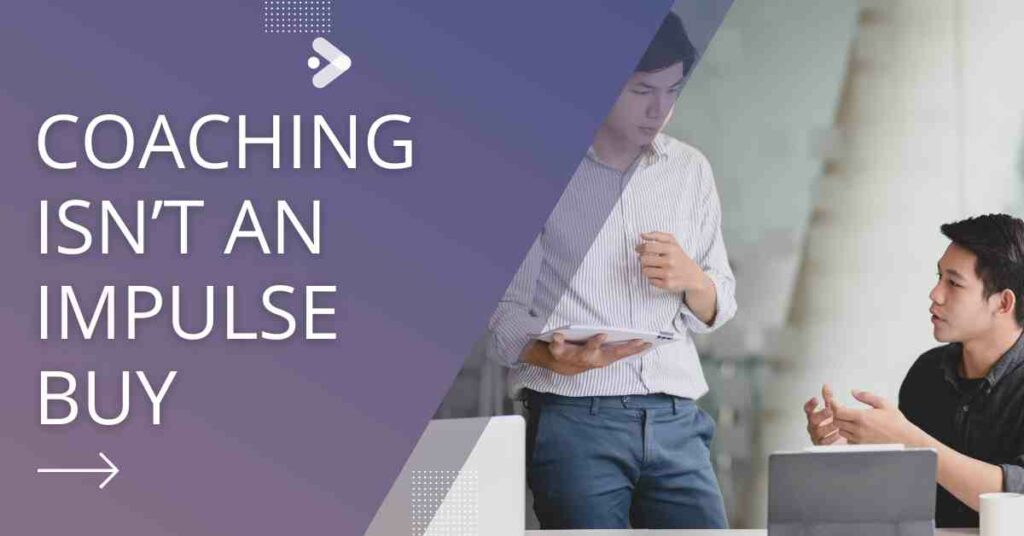
Coaching isn’t an impulse buy
Coaching is rarely, if ever, an impulse buy
It’s a serious investment for all but the wealthiest of people.
Rarely do people land on a coaching website for the first time and decide that particular coach is the one for them without exploring more.
People hire coaches who resonate with them and who they think they know, like, and trust.
Building that kind of relationship with a first-time visitor on your website is challenging.
Occasionally, clients hire me directly from my Hire Tim Page, but they are the exception, not the rule.
Also, they have almost always spent a lot of time digging through a lot of content and coaching testimonials.
This site has hundreds of pages, with blog posts from as long ago as 2013.
And anybody still not convinced about my level of experience can go to A Daring Adventure and see life coaching posts going back to 2006.
It’s obvious to anybody visiting that I’m highly experienced and have a wealth of experience.
That won’t be the case if you’re new or even reasonably new.
Your newsletter will allow you to build trust
A newsletter allows you to build trust with your ideal client.
And as nobody hires a coach who they don’t trust, that’s a fucking necessity!

Choosing Your ESP (email service provider)
My first ESP was Constant Contact back in 2006.
They were fine, but it was fiddly to use and expensive at a time when clients were thin on the ground.
Aweber was starting to develop a great reputation around 2008 for high levels of email deliverability, so I jumped ship.
I liked Aweber. The platform was easy to use and the costs reasonable, and I continued to run my A Daring Adventure list on it until 2018.
However, when I had this site, which at the time was called Coach the Life Coach, redesigned in 2016, I opted to go for a more corporate bells and whistles ESP in ActiveCampaign.
ActiveCampaign was a lot less intuitive than Aweber and significantly more expensive.
I liked it to start with, but as the price levels crept up and up and the technical support levels went down and down, I started to get restless.
I was paying $180 per month, and whereas I received that back in clients many times over, it was still a lot compared to other platforms.
With longer-term clients, I will often ask them to make me an admin for their ESP.
I want to take a look at the backend and their stats firsthand to see what’s going on and if/how I can help.
I started to notice more and more clients were on Mailerlite.
As an entry-level product (price-wise), I’d never really taken it seriously.
I incorrectly presumed that as it cost a fraction of what I was paying, it must be far inferior.
And in some respects, it is inferior.
The ability to segment lists as you are about to send an email in ActiveCampaign was awesome.
For example, if I decided I only wanted an email going to people who had opened the previous email, people in the UK, or people called Bob, it was dead easy to do it on the hoof.
That’s possible in MailerLite, but it’s much more time-consuming and fiddly.
But other than the segmenting, I seldom used many of the bells and whistles ActiveCampaign had, and all the stuff I wanted from an ESP was contained within Mailerlite.
It was also more intuitive, stable, and had a cooler, more attractive design.
I had cleaned my list drastically with ActiveCampaign to under 2,500, reducing my monthly payment to $125.
However, Mailerlite was around $35 per month with zero meaningful drop-off in performance.
I spent six months researching different ESPs’ and considered MailChimp (another platform several clients use) and Convertkit.
But I kept returning to Mailerlite because of the cost, simplicity and ease of use.
I finally moved over in June 2023, and my only regret is that I didn’t do it 2 years ago, I fucking love it!
The formatting can be a bit flaky if you edit in the actual email rather than in a word document before pasting it into the email, but that’s the only issue I have had.
You should do your due diligence, but I’m extremely happy to suggest Mailerlite to all my clients.
As such, I am an affiliate. But I’m an affiliate because I recommend it and not vice versa.
Click here to check out Mailerlite.

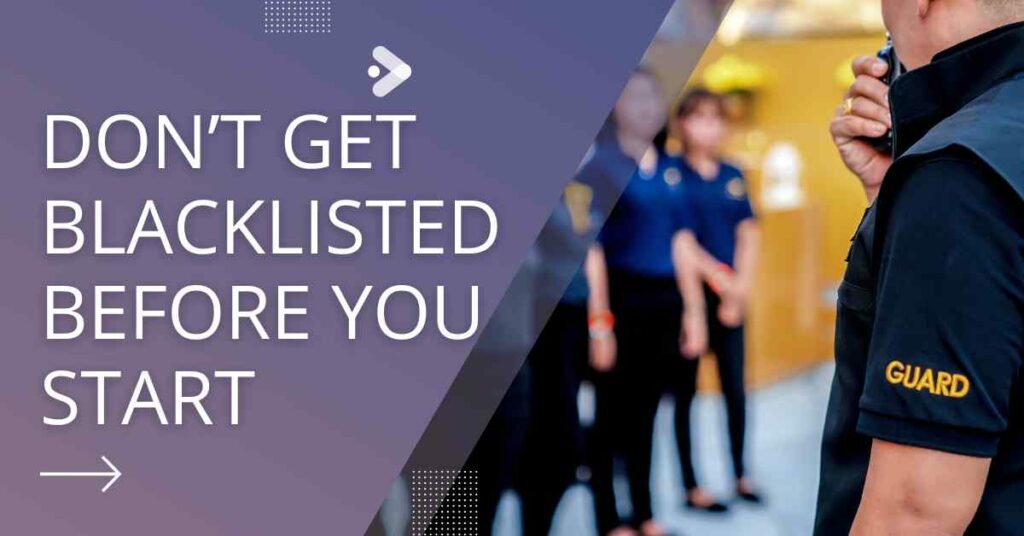
Don’t get blacklisted before you start
Once your ESP is set up, you have one very important step to take.
A step that 75% of clients I work with have never taken, almost always because they didn’t know to.
You need to authenticate your domain with your ESP and the company hosting your website.
If you have been smart enough to use MailerLite, they explain how to do it on this page.
If you’re with a different ESP, then search Google “How do I authenticate my domain with x” where X is your ESP.
This process lets mail servers know that you are at least somewhat legitimate, and it enhances your reputation.
The problem with not doing this is that your ESP will still let you send out emails, but it will seriously impinge on your ability to deliver them to the recipient.
As such, you should not start sending emails until you finish this process.
Note: If you have used a designer/developer for your website, they will probably be able to do this for you.
How do I get people onto my list – Step 1

Pretty much everything I help my clients do is aimed at getting potential clients onto their list.
We develop a social media strategy to get people on their list.
We implement search engine optimization to attract traffic and get people onto their list.
We look for opportunities to get in front of new audiences via podcasts, guest posting etc.
In other words, that topic is way too huge for this one post, but I cover it extensively both in blog posts like this as well as, yes, you’ve guessed it, on my list!
Alternatively, you can check out How to Get Coaching Clients Fast.
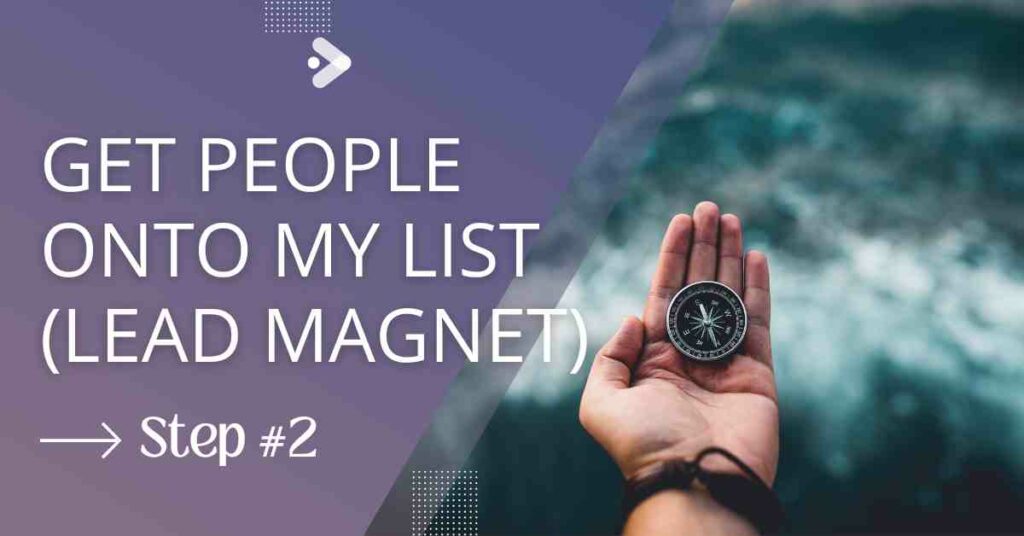
How do I get people onto my list – Step 2 (the lead magnet)
Whereas stage one is getting traffic to your website, stage two is converting that traffic onto your list.
And for that, you’re going to need a lead magnet.
A lead magnet can also be called an opt-in or a freebie and is what you use to tempt people to sign up for your newsletter.
When I opened my first email account with Hotmail way back in 1996, just getting an email was cause for excitement.
Unless you’re waiting for something very specific, I highly doubt you’re thrilled to open your inbox in the morning.
People have become more protective of their main email addresses than their firstborn and they are sick to death of spam.
Just slapping up a sign-up box with something generic like Sign up to hear about our latest product offerings and special offers is no longer sufficient.
You have to offer people something like:
- An ebook
- A checklist
- A quiz with a follow-up report
- A white paper or report
- An audiobook
- A series of videos
- A coupon code for discount*
As long as whatever you offer has genuine value and can be delivered electronically, then you’re good to go.
It shouldn’t be something you knocked together in 15 minutes whilst feeding the cat and doing your ironing.
Not should it be something ChatGPT concocted after a 12-word prompt.
And it most definitely should not be a sales letter masquerading as a freebie.
Your lead magnet is often your first real opportunity to wow your prospects.
Don’t blow that chance by giving them something free that also has salesy or cheap metaphorically written all over it.
If you cannot put your hand on your heart and say your lead magnet is worth at least $5 (preferably more), then it’s a shit lead magnet, and you need a new one.
* I wouldn’t offer a coupon code for coaching. You are far better off offering that in the lead magnet itself. Otherwise, it means anybody going to your site (even referrals) can immediately get you at a reduced rate.
What should I put in my emails (and how long should they be?)
Whatever you want, as long as it helps your audience.
The help may be in the form of actionable content.
I share many of my best tips on acquiring clients, most of which any coach can implement.
I will also share great resources like podcasts, marketing books, articles and tools.
I will advise about updates to Google, AI and marketing in general.
And selling your products or services fits into the helping people camp.
Presuming you’re a competent coach, that is.
Similarly, selling other people’s products or acting as an affiliate is helping your readers.
As long that is, you tell people you stand to gain financially, and you’re not pushing a pile of crap that you would never use buy or use.
I’m not recommending you sign up with MailerLite because I can earn money.
I’m doing so because I think it’s a brilliant, cost-effective service that I use.
Me earning money is merely creating a win/win.

Email structure – AIDA
There is an important framework in sales/copywriting called AIDA, and it stands for:
- Attention
- Interest
- Desire
- Action
In an ideal world, you should be able to run every email through that structure and tick each box.
In the real world, there will be occasions when that doesn’t happen, and it’s not a problem.
Having said that, you should always tick boxes one, two and four.
Attention – this is your headline, and if it doesn’t grab the recipient’s attention, they will never open the email, so all your work is for nothing.
Interest – Your headline can also generate interest, but the body copy has to be interesting if people are to move forward.
Desire – Desire can be anywhere on the scale of ‘Those socks look quite nice, I‘d like a pair to keep my tootsies all warm and snuggly.
To, ‘OMFG, I want that handbag sooooo badly I’m drooling. I think it’s worth raiding the kid’s college fund to pay for it. Education is sooooo overrated’ anyway
This stage will be your email’s body copy if you are selling something.
Or it could just be the body copy of an email talking about a blog post you have published, and you moving readers from interested in it to desiring to read it.
Action – This is the thing you want your readers to do after (or during) your email. This is your CTA (call to action).
Every email should have a CTA. And I do mean every fucking email.
About half of my emails have the following banner running across the bottom.

But it doesn’t have to be a link to a page for a product or service.
It can simply be a link to a blog post you have written.
Or a link to a book you suggest or a podcast you recommend.
Or, it doesn’t need to be a link at all, it can even be a request for the reader to respond to that email.

Should I Have A Blog Or A Newsletter?
Both because they serve different purposes.
Your blog can help you rank for various search terms (I rank for close to 200 on the first page of Google, and all bring me inbound organic traffic).
It’s also somewhere people can check you out before contacting you or signing up for your newsletter.
And if you want to apply for podcasts or to be interviewed, your blog will add credibility once you start to build a body of work.
Also, whereas emails rarely get read more than a couple of days after you send them out, I have visitors reading blog posts I wrote well over a decade ago.
Your newsletter, however, is a lot more intimate, and you can personalise it a lot more.
Here are some things you can do with a newsletter that you cannot do with a blog post.
- Only send to certain groups of people, based on criteria such as:
- Where they live
- When they subscribed
- What emails they have or haven’t opened
- What links they have or haven’t clicked on
- Scores of other parameters
- Segment your list – I have two lists, one for newbies and one for people who want more in-depth material
- Tag people based on their activity and sign-up details so they only get information that is relevant to them
- Use shortcode so that you can insert the person’s name and make it feel warmer and friendlier
- Give people the option to hit reply and send you a direct email (I get a couple of emails per week like this, and they are usually the people most likely to hire me)
Probably a better question is, ‘should I just send my blog posts to my newsletter list?’
There are three options available to you here, but let’s look at the most common two first.
- You write a blog post and then send out a newsletter telling people about it and linking back to the post so they can go and read
- You write a blog post and then dump the entire post in the body of the newsletter
With option number one you will get fewer people reading your article because some people just don’t like clicking away from their email platform, especially if they are on their phone.
But you are driving more traffic to your website and that’s important.
The more traffic you get (presuming it’s not coming from spammy sites), the more authority your site builds with Google.
The third option is to write new material for your newsletter readers, material that they cannot see just by visiting your blog.
By and large, this is what I do with The Fully Booked Coach, and probably 75% of my newsletters consist of exclusive material.
I will also share a lot of personal information such as earnings (something I did in September 2023), book sales, and stuff that has gone wrong and what I learned from it etc.
I prefer not to publish that kind of stuff on my blog.
You can argue for any of the three approaches I have just explained, and none are wrong, it’s a personal choice.
I prefer to mix and match, but you can choose whatever option you prefer.
Note: There actually is a 4th option where you put a part of the blog post in the email to get people to start reading, and then there is a link to continue. This can work well too.

Is the size of your list important?
Yes and no, and in any case, what’s more important than the size of your list is the engagement.
And by engagement, I mean open rates (more shortly), CTR (click-through rate), sales, social shares, people responding directly, etc.
In 2013, and prior to going full-time with Coach the Life Coach (the previous name of The Fully Booked Coach), I had over 12,000 people on the A Daring Adventure list.
As I was enjoying working with coaches so much, however, I’d neglected it. Consequently, engagement was low.
In fact, my current list of about 2,500 brings me a lot more clients than that list of 12,000 was doing.
12,000 felt good to my ego but not as good to my bank balance.
It would, however, open doors if I wanted to do a JV (joint venture) with a company wanting access to my list.
But as I rarely did JVs and I still hadn’t fully committed to only working with coaches, I decided to shake things up a bit.
I searched to see how many people who had been on my list for at least two years hadn’t opened any emails in that time.
It brought back almost 2,500 people, so I deleted them.
I then got braver and did a similar search for a year.
Almost 900 results were returned this time, so I deleted them too.
And voila!
Not only did my open rate for my next email shoot up, but I also took myself back below the 10k threshold, where I was paying more to my ESP. So I also saved myself some money.
If you’re only selling your coaching services and an average client is worth £10k, then a list of 200 super-engaged people who admire, respect and trust you may be enough.
If you only want a couple of clients per year from your list, as you also get referrals and clients from other sources, then that’s clearly achievable.
On the other hand, let’s suppose you have 2,500 people on your list, many of whom signed up many months or even years ago and who rarely hear from you unless you have something to sell them.
And that your open rate is 30% or under, even with MPP.
Then, it could be tough to get any clients.
Also, if your average client is only worth £1,000 to you, and you need 30 per year, then you’re probably a tiny bit fucked.
As such, you need to build engagement, and you do that by delivering more value and improving your open rate.

What is a good open rate?
It depends on any number of things, including, but not limited to:
- How often you hit your list
- How often you sell
- The age/size of your list
- How clean your list is
- The niche you serve
Open rate has historically been the most important metric other than sales.
But changes in the law and the introduction of Apple’s MPP (mail privacy protection) has meant that it’s not an accurate metric.
MPP means that anybody receiving your email on an Apple device will show as an open.
Apple downloads the message to its server to deliberately confuse an ESP into thinking that you opened it.
There will be plenty of people on Apple devices who read your emails, but unless they tell you, or click on a link within the actual email, you have no way of knowing for sure.
Coaches often think that if somebody signs up for their newsletter list then they will receive whatever email they send them.
Sadly and annoyingly, that’s not the case.
Just because you’ve sent out a newsletter to 1,000 people in no way does that mean 1,000 people will see it.
As with how often you hit your list, there is no right answer to the question of a good open rate.
There are so many variables, such as:
- Size of list
- Age/cleanliness of list
- Time of day/day of week
- Headline
- Industry
- How often you sell
Having said that, if you have over 500 people and you’re open rate is over 60% you’re doing very well.
If it’s under 40%, you have a serious problem.
The Fully Booked Coach is rarely under 50% and usually around 60% which is pretty good.
Below are four emails I recently sent out.
Even though there are over 2,500 people on my lists, I rarely send to everybody because not everything I send out is relevant/useful to everybody.
Notice how the third email down had a crushingly low open rate of 15.17%.
That was a re-enagagement campaign where I sent a tempting email to a segment of my list that hadn’t opened an email in a while.
Under such circumstances, that was a great response.
It is a good idea to try and re-engage people who you are considering cleaning from you list before you finally do so.
Speaking of cleaning your list…….
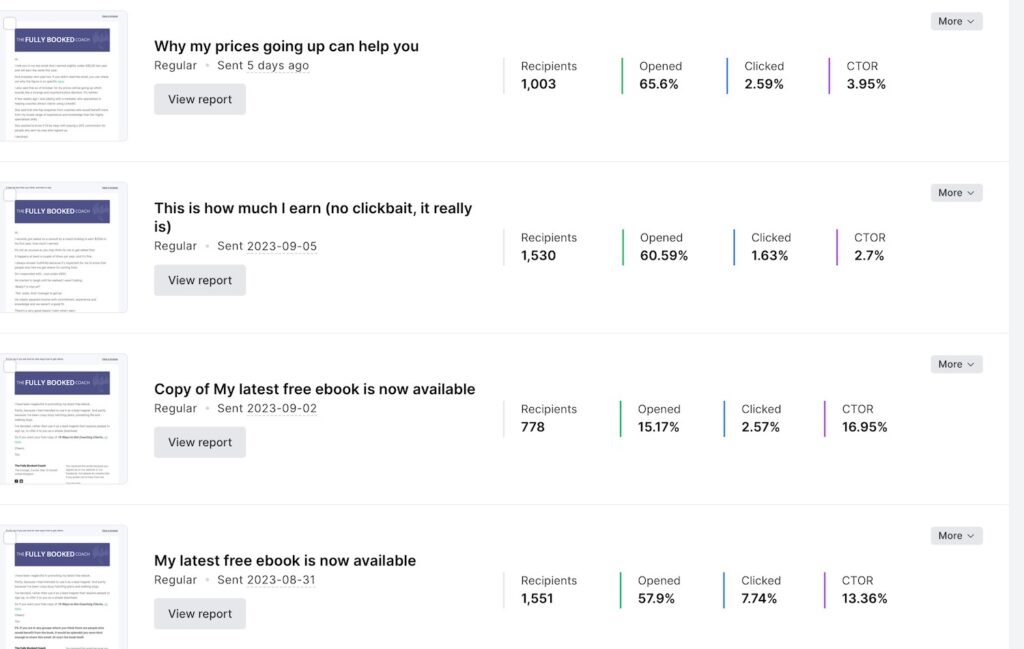

You must clean your list
Cleaning your list of inactive subscribers is critical to your success.
Suppose you have 100 people on your list and an average of 40 people open each of your emails.
That means you have an open rate of 40%.
But remember what I said about Apple’s MPP. That 40% os probably closer to 20/25% in reality.
Now, let’s suppose that you look at your analytics and notice that 50 people haven’t opened any email since they signed up over six months ago; the bastards!
You could let them sit there clinging to the hope that one day they will see the error of their ways and read what you have lovingly crafted.
But let’s get realistic.
If somebody hasn’t opened an email of yours in six months, it’s highly unlikely they will do so again.
In all likelihood, your emails are going straight into their spam or promotions tab, and hurting you.
ISPs and email platforms like Gmail, Apple and Yahoo Mail are monitoring open rates.
As such, you need to delete those people.
If you have terrible open rates, you’re presumed to send spammy and/or low-quality material.
The net result is that more of your emails get sent to spam or the promotions tab.
This leads to your open rate declining even further, and a downward spiral has started.
Removing people from your list who just don’t care what you have to say, OR aren’t seeing what you have to say, increases the likelihood that others who do care will see your emails.
Bearing this all in mind, let’suppose you take the brave and sensible step to delete the 50 people who aren’t opening your emails.
Then you send an email out to the 50 people left and the usual 25 open, plus the random number because of Apple, your open rate will probably be closer to 65%, which is great.
I wrote an in-depth post that gives a case study of a time I deleted 786 people from my Fully Booked Coach list if you want to know more about list cleaning.

How Often Should I Hit My List
There isn’t an optimal time or a correct answer to this.
Seth Godin sends an email every day, whereas Glen Allsopp at Detailed probably only drops into my inbox about once every two or three months. I read both.
Seth publishes short, punchy content spanning a wide spectrum and all aspects of ethical marketing.
Sometimes, his posts are 100 words or less and rarely longer than 350.
Seth is a superstar with tens of thousands of followers, probably hundreds of thousands, so it clearly works.
On the flip side, Glen writes incredibly in-depth heavily-researched content about SEO and goes narrow and very deep with equally excellent content.
He, too, has a large and loyal following.
As I have said, there really isn’t a right or wrong to this.
However, try to be somewhat consistent.
Do not disappear from your readers for three months and then hit them three times in a week because you have something to sell them.
If in doubt, send to your list whenever you have something of value to share with them.
There’s nothing especially wrong with writing to a schedule so long as it doesn’t mean you churn out subpar material just because your calendar says it’s time to post.
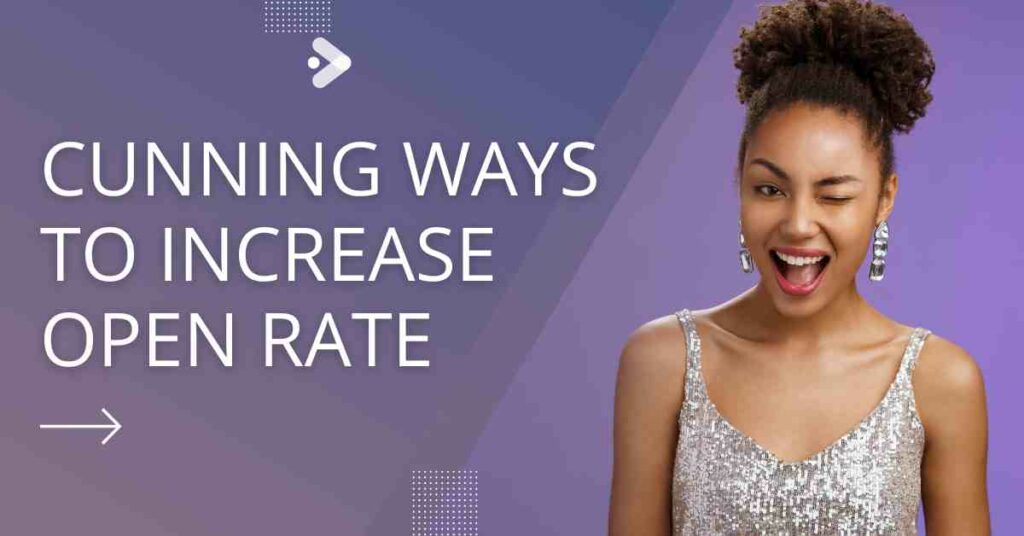
Using headlines to increase your open rate
The headline is the first thing people see, and if yours is boring and gives no reason for people to open, then guess what?
Yep, they won’t open it.
Arguably the greatest direct response marketer/advertiser of all time, David Ogilvy, stated that the headline was worth 80 cents of every advertising dollar because it was so important.
Using the headline ‘August Newsletter From Tim’ wouldn’t even entice your best friend to open it, never mind a busy prospective client.
However, the headline I used once of ‘Do You Wear Women’s Underwear?’ was intriguing to enough people to spike my open rate.
Clickbait headlines, can be super effective, presuming you don’t go nuts and oversell the post you.
30 Self Development Books Every Life Coach Should Read (and one they shouldn’t) is an example of a clickbait headline with the element in brackets designed to illicit enough curiosity to get people to open.
However, if you use clickbait, make sure it delivers on the promise it makes. Otherwise, you may get people to open once, but they won’t open twice.
If I wrote a headline, ’10 Shocking Tips To Acquiring Clients You Have Never Heard Of’
And then you clicked through, and number one is ‘open a Facebook account’, and number two is ‘start a blog‘, you’re going to think I’m a fucking idiot.

Use shortcode in headlines and body copy
Shortcode allows you to personalise your emails.
Without it, every email I send out would start Hi or something equally generic, which is not my style.
The are a multitude of shortcode options that all pull from the information that your ESP has stored about your subscribers.
I only ask for the email and first name of somebody when they sign up, and as such, I’m only ever going to use their first name.
I once had a client tell me he didn’t like how I sometimes put his name in the body of emails.
He said it felt spammy.
I replied: I see Mark. Are you saying no fucker ever uses the other person’s name when they are talking other than at the very beginning Mark?
Okay, so that conversation probably never happened, but you get my gist.
I realise that letters traditionally started with ‘Dear’, which was the last time the person’s name was used other than on the envelope.
But you’re not applying for a job, or admonishing your favourite washing detergent manufacturer for changing the freshly mown meadow-like smell.
Nor are you sending a letter home to your mum from the Western Front in World War I and starting with My Dearest Mother’
So, keep it informal.
I use shortcode to insert a name when I would normally use a person’s name.
I read emails back to myself several times and add the name when I’d add the name in a normal conversation.
I’m not trying to manipulate anybody. I’m just being me.
As well as using shot code in the body copy, you can also use it in the headline to increase open rates.
As an example, here is an email title I sent out recently:
Can you hire somebody to generate clients for you?
Here are two options I could have gone for using shortcode and my own name as the example that would probably have increased the amount of people opening the email.
Tim, can you hire somebody to generate clients for you?
Can you hire somebody to generate clients for you, Tim?
We are in murky territory here, and I’d advise caution in adopting such a strategy.
Used sparingly to grab people’s attention, it can be effective.
However, used too often, it will quickly become ineffective and tiresome, as well as spammy.
Especially when you make it seem even more personal by using a heading such as:
Can I ask a quick favour Tim?
Or, Have you heard about this Tim?
You risk people feeling stupid if they click on something that has gone to many people that they thought was meant just for them.
Another way to increase open rates is to resend the same email to people who didn’t open the first one.
It’s wise to change the subject line so that it’s not obvious if the first one is still sitting in their inbox.
Also, it may have been the original subject line that didn’t appeal to them.
Although this tactic can work, it is less effective the more you email your list.
I would not adopt this approach if you email weekly or more often, as you risk flooding people’s inboxes.
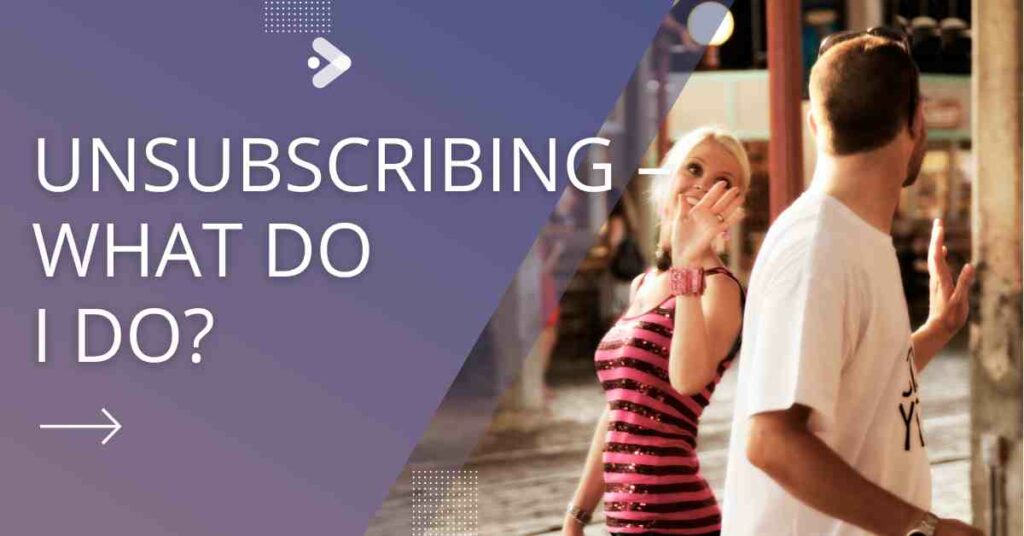
People are unsubscribing – What do I do?
Smile broadly and then wave them a cheery goodbye.
It’s not personal. It’s not even about you.
They are doing what they think is right for them at that moment in time.
The truth is, they’re doing you a favour.
People will unsubscribe from your newsletter for all sorts of reasons, such as:
- They’re getting inundated with emails in general and want to cut back
- They’re no longer interested in what you have to say
- You may have caused them offence for any number of different reasons
- They subscribed with a new email address and don’t want duplication
- They did it by mistake in a pre-coffee early morning haze
- They don’t realise you’re trying to run a business and resent being sold to
- They’re fucking idiots missing out on your undoubted genius
None of those is within your control, so let it go and let them go.
The reality is that you want people unsubscribing for two reasons:
- It cleans your list au natural
- It means you’re polarising people
We’ve already covered list cleaning and its importance, but polarization is far more important when it comes to your marketing as a whole.
I used to be very vanilla in my early days of sending out newsletters and writing blog posts.
It is hard for people who follow me now to believe, but I was scared to death of upsetting people.
The first stat I’d look at after sending out an email was the unsubscribe feature and fret if it was higher than usual.
Over time, it became exhausting trying to appeal to everybody and stifle my natural inclination to be salty, honest and use a lot of humour.
So I started to change.
This approach doesn’t get me the most clients, but it does get me the best clients. At least, best for me.
If me typing the word ‘fuck’ is going to have you meltdown and choose to get all offended, then we’re not right for one another.
My swearing and talking politics, as well as using a lot of humour in my writing at A Daring Adventure was very much part of my brand.
It was what helped me find a blue ocean in a sea of red without even needing a niche.
Sure, 75% of people who stumbled upon my site didn’t ‘get me,’ and that’s fine because I could focus on the 25% who did.
You being you, will get unsubscribes, and you don’t need to be as acerbic and sarcastic as I can sometimes be.
It may be that you turn somebody off because you are religious, or because you’re not religious.
Or that you drop into a post your love of meat to a vegan.
Or it could be that you mention you’re gay to a homophobe.
There are 1,001 ways for people to choose to be offended – let them get on with it because it’s no concern of yours.
And they were never your people anyway.
People who are likely to hire or buy from you are highly unlikely to unsubscribe.

How often should I sell to my list?
I rarely sell to my list outside of full-on launches.
I only used to run one Coach The Life Coach (the predecessor of The Fully Booked Coach) course per annum, which is low.
But I usually run one or two masterminds per year. Or I have somebody leave a mastermind and want to fill that slot.
Prior to each course, I would schedule what is called a launch sequence.
With the Thanksgiving/Christmas coaching offer I would offer once per annum at A Daring Adventure, I could afford to send out just one email.
As mentioned, I had 12,000 people on that last and never offered more than three places.
Consequently, I didn’t need to warm up my audience or batter them over the head because I knew all places would be gone within 24 hours.
I wouldn’t be able to say that if I ran another Fully Booked Coach course.
I would almost definitely need to do a full launch sequence of between 7 and 10 emails.
If I just sent one email out saying, Come and get it, the course is open for business – hurry, hurry, hurry, I’d probably have one or two people sign up who were already waiting for the next course.
Other than that, it would be crickets and tumbleweed.
A launch sequence is just that, a sequence of emails over a limited period of time (often between 7 and 10 days) and would look something similar to this, and I’ll use my course as a demonstration.
- Day 1 – Early bird launch with pricing and link to enrol
- Day 2 – Story about the power of learning in groups
- Day 4 – Story about an element of the course
- Day 5 – FAQs – is the course right for you with links to the course page
- Day 6 – Story about a different module of the course and how I made it work to get clients
- Day 8 – Testimonials from previous attendees and/or success story
- Day 9 – Early bird ending tomorrow, only x number of spaces left
- Day 10 – Early bird ending today – only x number of places
Every email should contain at the very minimum a PS with a CTA (call to action) that takes people to a sign-up page.
I would possibly make the FAQ CTA something like, ‘If you’re still unsure or have a question I haven’t answered, hit reply and ask away – I personally answer every email‘.‘
The Fully Booked Coach (Coach the Life Coach) client acquisition course usually had an early bid of $999 and a full price of $1,499.
An average client when I was a life coach was then worth about $1,500 to me, and I’d hope you are no lower than that.
So, to validate the course’s worth, I’d need to be able to help you acquire a single client.
Of course, you have to implement what I share with you diligently, but there’s no doubt it works.
However, as human beings we rarely buy based on facts; we buy on emotions and then justify it with facts after the event.
Therefore, as well as delivering the raw facts, I also have to tell stories that help you understand that I was once a struggling coach with no clients, just like you.
People love stories because they allow us to then relate to a person and/or situation.

Conclusion
There has been a lot of online talk over the last few years as to whether newsletters are, if not dead, then on life support because of the rise of social media.
Nothing could be further from the truth.
Most marketing on social media is interruption marketing.
Businesses have to stop you from doing what it is you are doing to gain your attention.
Newsletters are permission marketing.
The people on your list have given you express permission to contact them, unlike anybody seeing ads scrolling through Facebook or Instagram.
Yes, it’s harder than it once was to market to your list simply because it’s harder to get your emails delivered and then opened.
But, it’s still easier and more effective than almost any other marketing method.
And it’s effectively free.
I’m sure there are successful coaches without a newsletter list, but I doubt there are any who work exclusively online.
Glossary or Terms (thanks ChatGPT!)
- Subscriber List: A collection of email addresses used to send email marketing campaigns.
- Segmentation: Dividing your email list into smaller groups based on certain criteria (e.g., client type, how they found your services) to send more targeted and relevant emails.
- Lead Magnet: A free resource offered in exchange for an email address (e.g., a coaching tips eBook or a free webinar).
- Open Rate: The percentage of recipients who opened the email.
- Click-Through Rate (CTR): The percentage of recipients who clicked on a link within the email.
- Bounce Rate: The percentage of sent emails that were not delivered to the recipient’s inbox.
- A/B Testing: Sending two slightly different versions of an email to see which one is more effective in terms of engagement or conversions.
- Autoresponder: An automated email or series of emails sent to subscribers based on specific triggers or intervals.
- Drip Campaign: A set of pre-written emails that are sent out on a predetermined schedule to nurture leads or educate clients.
- Personalization: Tailoring the email content to individual recipients based on data you have about them.
- ESP (Email Service Provider): Platforms like Mailchimp, ConvertKit, or SendinBlue that facilitate the sending, tracking, and management of email campaigns.
- Unsubscribe Rate: The percentage of recipients who opt out of receiving future emails.
- CAN-SPAM Act: U.S. law that sets requirements for commercial emails and establishes penalties for violations. Euope has GDPR
- Responsive Design: Ensuring emails look and function well on all devices, especially mobile phones.
- Call to Action (CTA): A prompt within the email urging the reader to take a specific action, like “Book Now” or “Read More”.
- Landing Page: A web page where email recipients are directed to once they click a link in the email, optimized for a specific action or conversion.
- Email Analytics: Data and metrics that provide insights on how recipients interact with an email.
- List Hygiene: The practice of regularly cleaning and updating your email list, removing inactive or unresponsive subscribers.
- Subject Line: The main title of the email, crucial for enticing recipients to open the message.
- Deliverability: The ability of an email to successfully reach the recipient’s inbox, avoiding spam or junk folders.

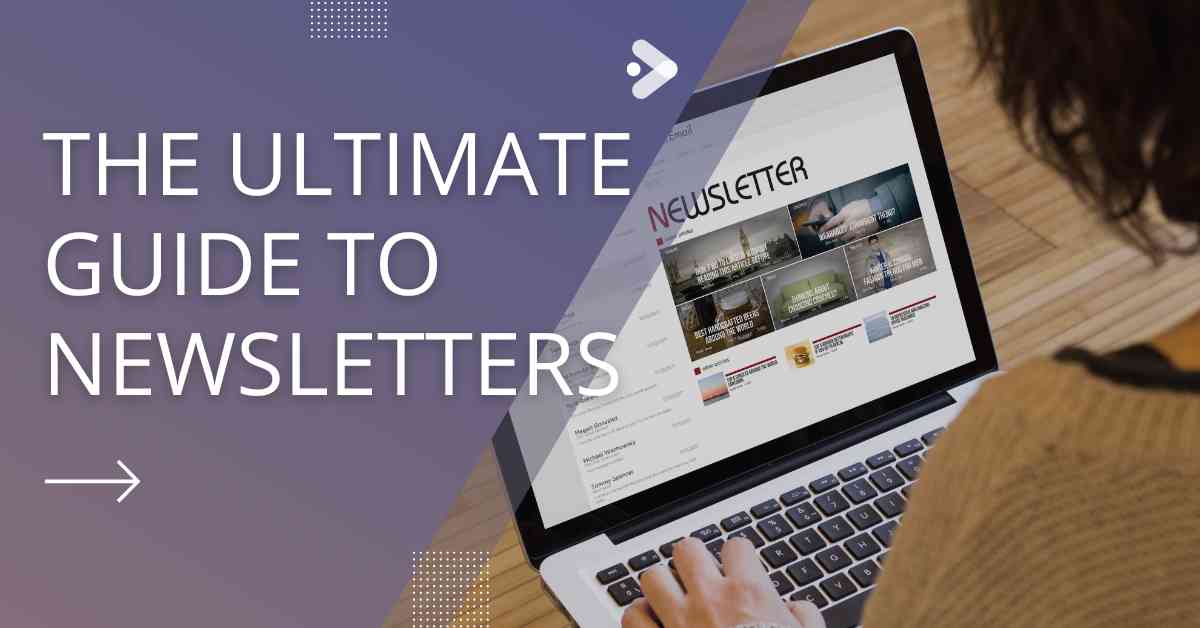
Now THIS is good info! Thanks for your honesty and time, j stumbled upon you through Feedly and I’m so glad I did!
Great stuff Colete and very happy to have you here.
Just so you know – I open every thing you send – why? Because 99% of what I have read of yours is always pure gold information – including the humor, sarcasm, swearing and all around good natured fun you provide. Because I always get a least one good laugh in – there is no way I wouldn;t open one of your emails! God knows most of us are too serious anyway and need a good laugh daily. This one I will have to reread because there is a lot of good information on list building and all those nit picky details that unfortunately are important. Thank you Tim. Shivam
Great stuff and glad I’m helping Shivam.
This made me sign up instantly!
Brilliant, thanks Jade!
Tim,
Thank you for a well written, detailed and immediately helpful article. Much of your advice is relevant to any business and will be implemented in my husband’s, not to mention my own,
Amy
You’re absolutely right Amy and even though it’s written for coaches I’m glad you can put it to good use elsewhere.
Excellent post and am making a change to my business plan that I am submitting to you on March 10 (saving you the time now of telling me to change it!).
Excellent!
This is brilliant! Thanks!
Hi there,
I was actually doing research into how to get content for newsletters when I came across this article.
Bit of background… I work for a Life Coach academy in South Africa selling Life Coaching courses. But sales or selling is not my strong suit – it’s a bit like pulling teeth for me.
Another opportunity is available for me in the same company and one of my responsibilities would be to write a regular newsletter.
Now, even though I love writing, I am concerned that I would, at some point, run out of ideas for new content especially when I HAVE to do it every week/month and not only when inspiration strikes.
These newsletters will be sent to:
1. New leads who are interested in qualifying as Life Coaches and
2. To our qualified coaches.
Do you know of any providers that are able to assist with relevant newsletter content?
Any other feedback you may have about this will be very helpful and greatly appreciated.
Thanks in advance,
Clem
I wouldn’t worry too much about running out of ideas. It’s a common concern that rarely happens.
As for providers. There will be some, but finding good ones who know the topic is tricky at best.
I’d be happy to put on a webinar/training session for your pupils at some stage. And other than mentioning what I do it wouldn’t be salesy.
Looking at your site, at the moment you’re seriously hurting through lack of traffic, and companies like iNLP are killing that. Let me know if I can help.
Brilliant piece!
I love the way you write Tim, and you have definitely given me some insight into the mysterious world of newsletters!
I look forward to following you! Thank you!
Warm regards, Tiffany
Glad you enjoyed it Tiffany!
Hi Tim! I am Caterina and am a Spiritual Life Coach and Mindset Expert. Needless to say, I am grateful to you and your thoroughness in this post/blog. I was realizing over the weekend that I need to start getting MORE people in my email list. I only have 5 right now but I am excited to watch it GROW. I agree with so much of what you said and that is why it made me happy to find your article in my doing research on the topic. I took it all in and am excited to implement it now!
I have a blog I regularly post on my website and was thinking I’d start with that for now as the main body of my email. I know people’s attention spans are usually really small so I figure I could experiment as you did, to see what is most effective. For sake of keeping track of the numbers, how do you do that? Is it simply an excel spreadsheet of some sort you make yourself or is it something you get through a mail service you use? I saw you say you currently use mail chimp. Why did you switch to that and what makes it better than what you had? I ask because I currently have a Gmail account but am considering the idea of switching to another service that offers everything Google does but is more encrypted and safe for security reasons if that makes sense. May not do it right away, just work with what I have but figured getting your feedback couldn’t hurt. Your time put into making this is wonderfully well done!! Worth it in every single section. =]]
Thanks for your assistance and have a wonderful day!
Caterina
Hi Caterina, I didn’t say I used MailChimp, I use Active Campaign which is brilliant.
I do have clients who use MC and it’s ok, it just doesn’t have (from what I know about it) the scalability and flexibility of Active Campaign.
And yes, you track everything in there and there are more metrics than you will ever need.
You must sign up for a platform otherwise as you grow your list you will start getting flagged for spam if you just use something like GMail.
This is an affiliate link to Active Campaign, but I’m an affiliate because they are brilliant.
Thank you so much. Really honest, frank and detailed resource.
Appreciate you spending the time writing it and all your other emails I get.
Thank you
You’re welcome Sam!
Tim,
As always, I love your posts. However, there’s one sentence where I got distracted and started searching the rest of the post to find the answer. You wrote… “But I usually run one or two masterminds per year (the next one starts in August 2021 if you’re up for it!)”.
Dude, where’s the link to the Mastermind? LOL, I want to know more.
Thanks for the rewrite of this post. I liked it the first time and liked it this time.
Vonie
Lol, sorry Vonie, I haven’t finalized everything yet!
I’m hoping to get the first email out about it next week.
The only thing I can say at this stage is that it will be shorter than my usual one and will run until mid-December.
Thanks Tim.
I admit that I have about 7 of your emails waiting to be opened and read right now. I keep them to one side for when I have the time and attention, and that seems to have been scarce recently. Making a dedicated time going forward because you share so much value so succinctly and in an easy to digest format. Really enjoying learning from you!
Oh nooooo. Get them read!